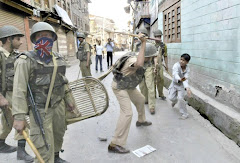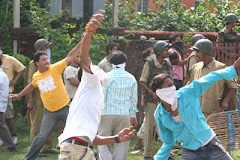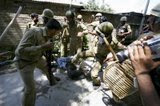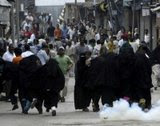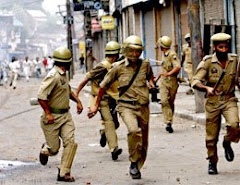Murdered farmer's family wants justice -THEY SHATTERED OUR HAPPY FAMILY: MOTHER
courtesy: Daily Greater Kashmir dt. Dec. 26th, 2008 by ARIF SHAFI WANI
Chatpora, (Shopian), Dec 25: “Where’re you my beloved” repeatedly shouted Rafiqa Begum, whose husband, Ghulam Hassan Malla, the lone breadwinner of the family, was killed in custody by troopers of 62 Rashtriya Rifles last month just for objecting to the ‘obscene act’ of a soldier. She is lone witness to the incident when a RR trooper threatened to kill her husband after he objected to the soldiers ‘immoral behaviour’. Rafiqa is so shocked by her husband’s killing that she is unable to talk about the incident. Rafiqa’s is crazy with grief. For past 20 days, villagers, including womenfolk gather around her under construction single storey house and try to console her but in vain. “Her husband’s killing has affected Rafiqa psychologically. She sits on the verandah and weeps for the whole day. Malla was the lone breadwinner and male member of the family,” said Zaina, her neighbor, as she could not hide her tears. As some villagers showed Malla’s photograph to this reporter, Zaina stood up and grabbed it. She passionately kissed the photograph and broke down. The villagers tried to snatch the photograph but she wouldn’t let it go. “The troopers have shattered my happy family,” said Malla’s aged mother Sajja. “My son was innocent and killed for objecting to wrongdoings by the troops. He is a martyr,” she said. Recounting the fateful day, Sajja said as a routine Malla left to work in the nearby orchards. “He had objected to the soldier’s immoral behaviour with a local girl. The soldier threatened him of dire consequences upon which Malla had a heated argument with him,” she said. Next day, she said the army launched a cordon-and search operation in the village and asked for Malla. “Despite our protests, they took my son along with them promising to release him after questioning. However, when he was not released, I along with other villagers rushed to the camp. The troops assured us that Malla was well and would be released soon,” Sajja said. However, next day, the troops called some villagers, including Malla’s cousin, Bashir Ahmad to the camp. The army men told them that had Malla died during interrogation. “We were shocked to see his body in a pool of blood as the brutal men in uniform had burnt his private parts and broken his wrist. Blood was still oozing from his nostrils, mouth and ears. The walls of the room were splattered with bloodstains. A stove and knives used for killing Malla were near his body. We refused to take the body and informed the police first,” Bashir said. As the news of Malla’s custodial killing reached his native village, people, including women had marched towards the RR camp. “For the first time in 20 years, the villagers staged demonstrations against Army and even attacked the RR camp. However, the troops severely thrashed the protesters injuring dozens of them,” the local said. To prevent the situation from escalation, the authorities had imposed curfew in the district. “The troops took our photographs and threatened to implicate us in false cases. But we offered resistance and continue to stage protests against the killing,” the locals said. Ironically police has filed FIR against nearly 70 protesters for protesting against the murder. Succumbing to public pressure, authorities registered a case of abduction and murder case against Major S K Saroj and his troops. Sensing trouble, the locals alleged that Army offered money to the family. “Despite living in abject poverty, we rejected the Army’s offer to hush up the case in lieu of five lakh rupees. Can a mother do sell-out of son’s blood,” Sajja said. Director General of Police Kuldeep Khoda said an FIR 93/08 under section 342/302 has been registered against the accused Major and troopers. “We have booked Major SK Saroj and his troopers for abduction and murder of Malla. The investigation of the case was being pursued vigorously,” the DGP said. However, Malla’s cousin, Muhammad Iqbal who filed the case against the Army, said, “It is surprising that the Major and his troopers have not been arrested yet. The Army has shifted the accused Major from the Camp. They should be hanged for committing the heinous crime. The authorities are trying to weaken the case to boost the morale of its troops,” Iqbal said.


















